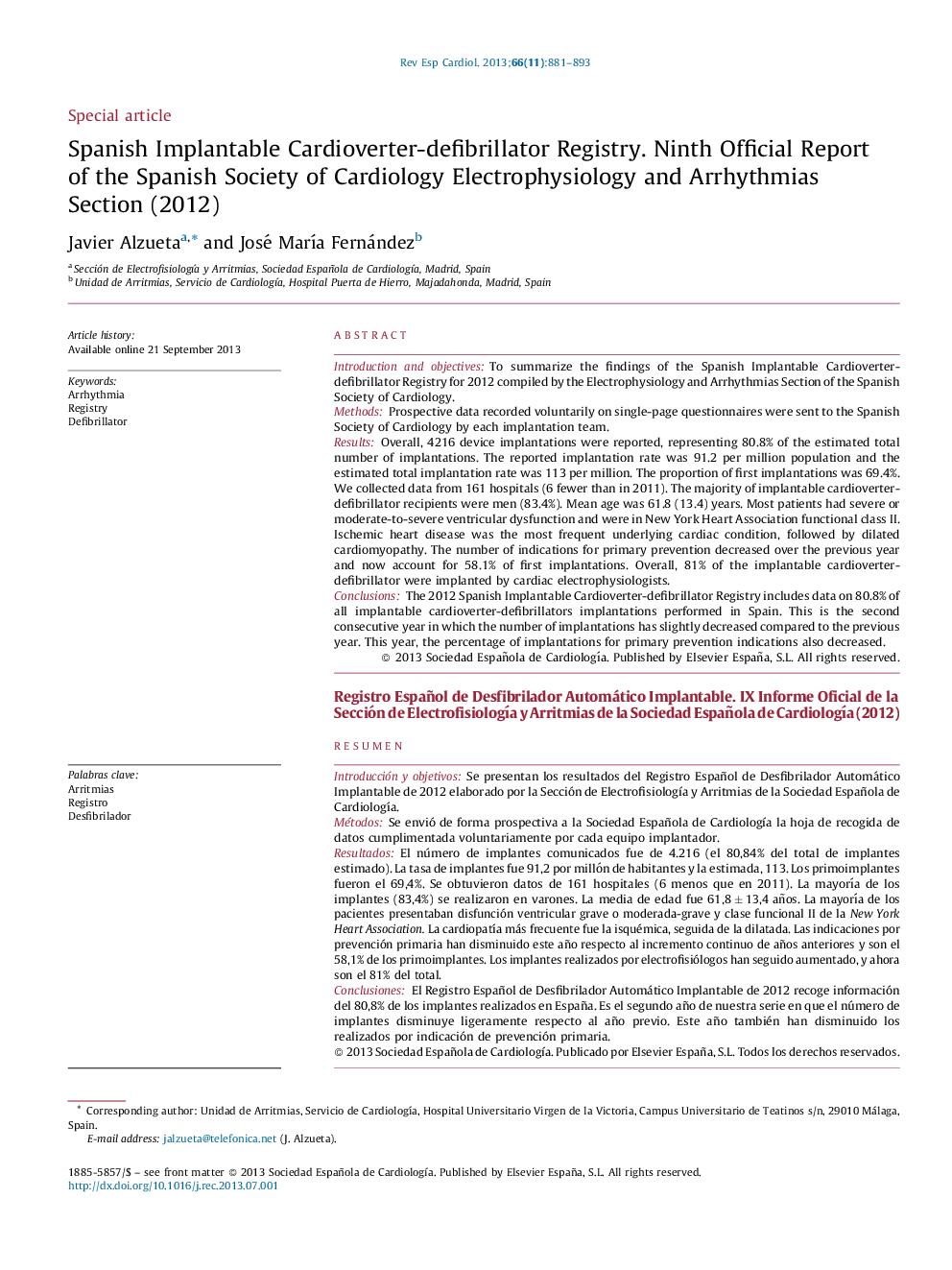| کد مقاله | کد نشریه | سال انتشار | مقاله انگلیسی | نسخه تمام متن |
|---|---|---|---|---|
| 3016645 | 1182090 | 2013 | 13 صفحه PDF | دانلود رایگان |

Introduction and objectivesTo summarize the findings of the Spanish Implantable Cardioverter-defibrillator Registry for 2012 compiled by the Electrophysiology and Arrhythmias Section of the Spanish Society of Cardiology.MethodsProspective data recorded voluntarily on single-page questionnaires were sent to the Spanish Society of Cardiology by each implantation team.ResultsOverall, 4216 device implantations were reported, representing 80.8% of the estimated total number of implantations. The reported implantation rate was 91.2 per million population and the estimated total implantation rate was 113 per million. The proportion of first implantations was 69.4%. We collected data from 161 hospitals (6 fewer than in 2011). The majority of implantable cardioverter-defibrillator recipients were men (83.4%). Mean age was 61.8 (13.4) years. Most patients had severe or moderate-to-severe ventricular dysfunction and were in New York Heart Association functional class II. Ischemic heart disease was the most frequent underlying cardiac condition, followed by dilated cardiomyopathy. The number of indications for primary prevention decreased over the previous year and now account for 58.1% of first implantations. Overall, 81% of the implantable cardioverter-defibrillator were implanted by cardiac electrophysiologists.ConclusionsThe 2012 Spanish Implantable Cardioverter-defibrillator Registry includes data on 80.8% of all implantable cardioverter-defibrillators implantations performed in Spain. This is the second consecutive year in which the number of implantations has slightly decreased compared to the previous year. This year, the percentage of implantations for primary prevention indications also decreased.
ResumenIntroducción y objetivosSe presentan los resultados del Registro Español de Desfibrilador Automático Implantable de 2012 elaborado por la Sección de Electrofisiología y Arritmias de la Sociedad Española de Cardiología.MétodosSe envió de forma prospectiva a la Sociedad Española de Cardiología la hoja de recogida de datos cumplimentada voluntariamente por cada equipo implantador.ResultadosEl número de implantes comunicados fue de 4.216 (el 80,84% del total de implantes estimado). La tasa de implantes fue 91,2 por millón de habitantes y la estimada, 113. Los primoimplantes fueron el 69,4%. Se obtuvieron datos de 161 hospitales (6 menos que en 2011). La mayoría de los implantes (83,4%) se realizaron en varones. La media de edad fue 61,8 ± 13,4 años. La mayoría de los pacientes presentaban disfunción ventricular grave o moderada-grave y clase funcional II de la New York Heart Association. La cardiopatía más frecuente fue la isquémica, seguida de la dilatada. Las indicaciones por prevención primaria han disminuido este año respecto al incremento continuo de años anteriores y son el 58,1% de los primoimplantes. Los implantes realizados por electrofisiólogos han seguido aumentado, y ahora son el 81% del total.ConclusionesEl Registro Español de Desfibrilador Automático Implantable de 2012 recoge información del 80,8% de los implantes realizados en España. Es el segundo año de nuestra serie en que el número de implantes disminuye ligeramente respecto al año previo. Este año también han disminuido los realizados por indicación de prevención primaria.
Journal: Revista Española de Cardiología (English Edition) - Volume 66, Issue 11, November 2013, Pages 881–893